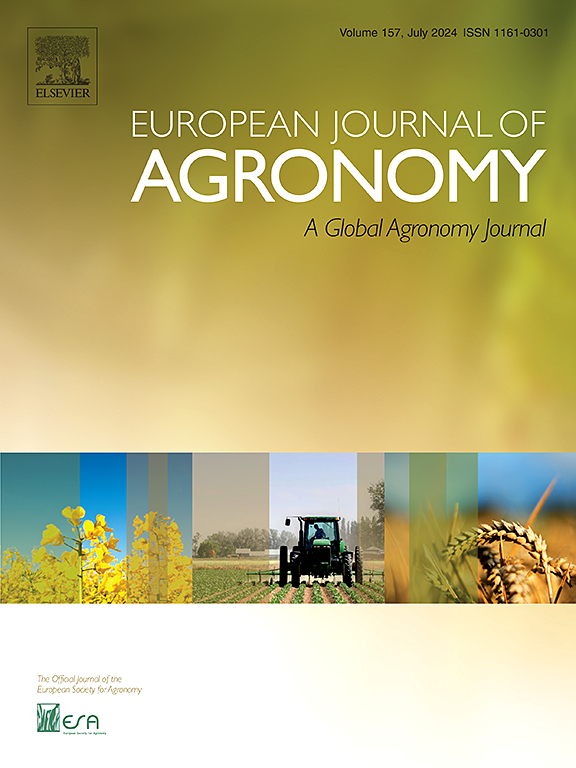结合物候学知识和贝叶斯网络绘制华南地区种植格局
IF 4.5
1区 农林科学
Q1 AGRONOMY
引用次数: 0
摘要
作物地图在区域和国家层面的农业遥感应用中发挥着至关重要的作用,特别是在监测农田利用、模拟种植强度、估计作物产量和评估农业可持续性方面。现有的作物映射方法主要依赖于机器学习算法,这些算法往往严重依赖于样本数据,缺乏可移植性。作物遵循相对稳定的季节性生长模式,这可以通过时序遥感数据捕获。同一种植模式下作物物候特征的相似性和不同种植模式下作物物候特征的差异性是作物作图的基础。本研究提出了一种将物候知识整合到贝叶斯网络框架中的作物制图新方法。通过提取关键物候特征,利用少量样本对作物物候知识进行编码,建立了江汉平原作物物候图谱的贝叶斯网络模型。几个关键物候阶段的光谱和地球物理指标被用作特征节点。该方法在冬小麦、冬油菜籽、水稻、大豆、玉米等作物类型复杂的江汉平原进行了验证。该方法具有良好的性能,总体准确率为93 %,Kappa系数为0.92。结果表明:(1)物候知识允许在不需要样本(或使用很少的样本)的情况下推导模型参数,而准确性没有显着降低。(2)该方法具有很强的鲁棒性和可移植性。提出的方法支持“弱学习和强推理”,消除了推理过程中的不准确拟合,增强了模型的可解释性和可移植性。本文章由计算机程序翻译,如有差异,请以英文原文为准。
Integrating phenology knowledge and Bayesian networks to map cropping patterns in South China
Crop maps play a crucial role in agricultural remote sensing applications at both regional and national levels, particularly in monitoring cropland use, simulating cropping intensity, estimating crop yields, and assessing agricultural sustainability. Existing crop mapping methods primarily rely on machine learning algorithms, which often depend heavily on sample data and lack portability. Crops follow a relatively stable seasonal growth pattern, which can be captured through time-series remote sensing data. The similarity in phenological characteristics of crops with the same cropping pattern and the differences between those of different cropping patterns serve as the foundation for crop mapping. This research proposes a new method for crop mapping by integrating phenological knowledge into a Bayesian network framework. By extracting key phenological features and encoding crop phenology knowledge with a small number of samples, a Bayesian network model was developed for mapping cropping patterns on the Jianghan Plain. Several spectral and geophysical metrics from key phenological stages were used as feature nodes. The method was validated on the Jianghan Plain, which has a complex cropping pattern with diverse crop types, including winter wheat, winter rapeseed, paddy rice, soybean, and corn. The method demonstrates excellent performance, achieving an overall accuracy of 93 % and a Kappa coefficient of 0.92. The results demonstrate that: (1) Phenological knowledge allows model parameters to be derived without the need for samples (or using very few samples), with no significant reduction in accuracy. (2) The method exhibits strong robustness and portability. The proposed approach enables "weak learning and strong inference," eliminating inaccurate fitting during the inference process and enhancing both the interpretability and portability of the model.
求助全文
通过发布文献求助,成功后即可免费获取论文全文。
去求助
来源期刊

European Journal of Agronomy
农林科学-农艺学
CiteScore
8.30
自引率
7.70%
发文量
187
审稿时长
4.5 months
期刊介绍:
The European Journal of Agronomy, the official journal of the European Society for Agronomy, publishes original research papers reporting experimental and theoretical contributions to field-based agronomy and crop science. The journal will consider research at the field level for agricultural, horticultural and tree crops, that uses comprehensive and explanatory approaches. The EJA covers the following topics:
crop physiology
crop production and management including irrigation, fertilization and soil management
agroclimatology and modelling
plant-soil relationships
crop quality and post-harvest physiology
farming and cropping systems
agroecosystems and the environment
crop-weed interactions and management
organic farming
horticultural crops
papers from the European Society for Agronomy bi-annual meetings
In determining the suitability of submitted articles for publication, particular scrutiny is placed on the degree of novelty and significance of the research and the extent to which it adds to existing knowledge in agronomy.
 求助内容:
求助内容: 应助结果提醒方式:
应助结果提醒方式:


